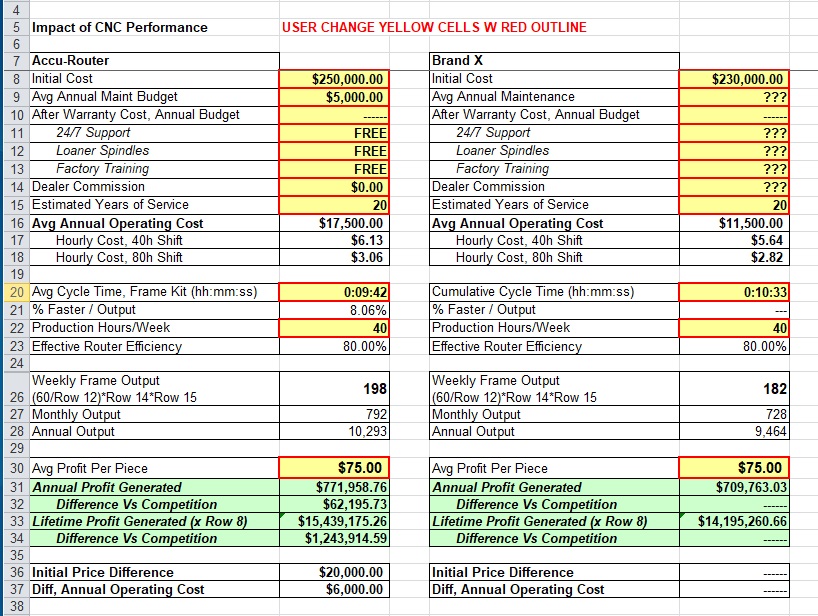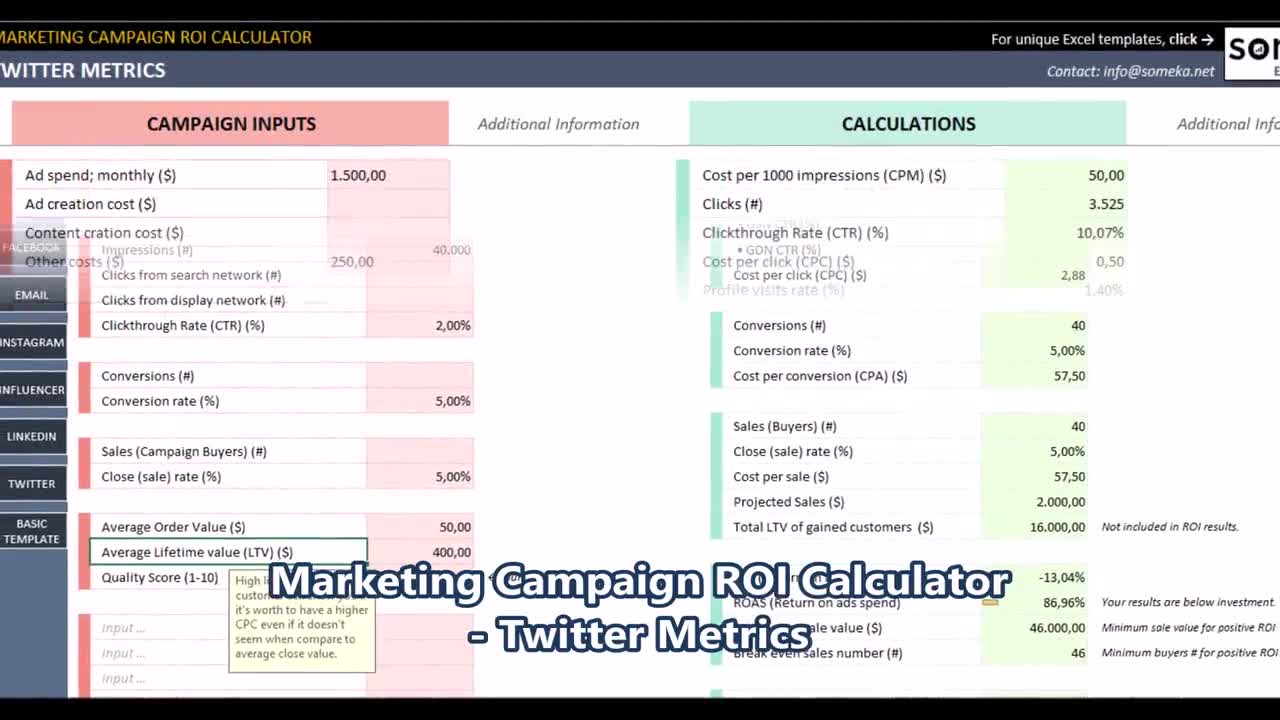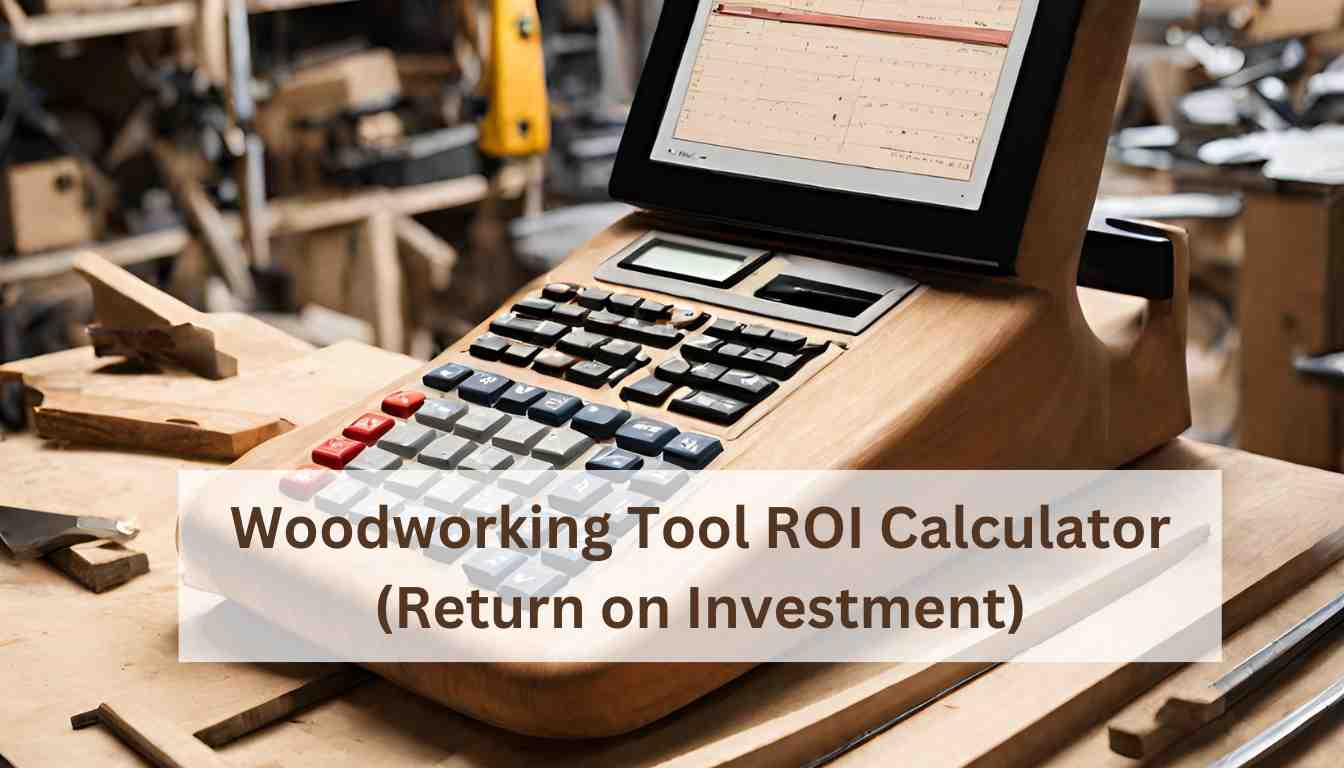A Woodworking Tool ROI Calculator quantifies the return on investment for woodworking tools. It assesses tool profitability and value over time.
Woodworking Tool ROI Calculator
Crafting success in woodworking demands efficient investment in quality tools. Knowing the financial implications of purchasing equipment is vital for any woodworker, from hobbyists to professionals. An ROI calculator specifically for woodworking tools helps in making informed decisions by evaluating the long-term returns on these vital investments.
It factors in purchase cost, operational expenses, maintenance, and the tool’s projected lifespan to provide a clear financial picture. With the woodworking industry evolving, and the cost of tools rising, such a calculator is an indispensable asset. It empowers woodworkers to strategically allocate their funds, ensuring every dollar spent contributes to higher productivity and profit margins.

Credit: www.woodworkingnetwork.com
Essential Woodworking Tools: Prime Investments
Crafting with wood asks for skill, creativity, and the right tools. The setup you choose can transform woodworking from a hobby to a career. Smart investments in essential tools pay off in the long run, boosting both efficiency and quality.
The Cornerstones Of A Woodworker’s Arsenal
There are tools that every woodworker needs. These are the non-negotiables for creating masterpiece after masterpiece. Let’s dive into the must-haves for your workshop.
- Table Saw: The workhorse of the shop, precise and versatile.
- Chisels: For detailed work and fine adjustments.
- Power Drill: A tool that effortlessly creates holes and drives screws.
- Sanders: To smooth surfaces and round edges easily.
- Measuring Tools: Accuracy defines quality in woodworking.
Cost Vs. Value In Woodworking Equipment
Investing wisely in woodworking tools means understanding cost versus value. An expensive tool that lasts and performs well is worth it. On the other hand, cheap tools often lead to poor results and replacements costs.
| Tool Type | Cost Range | Value Factor |
|---|---|---|
| Table Saw | $500-$3000 | High efficiency, durability |
| Chisels | $100-$500 | Longevity, precision |
| Power Drill | $50-$250 | Utility, convenience |
| Sanders | $50-$600 | Surface finish quality |
| Measuring Tools | $20-$200 | Measurement accuracy |
Calculating Roi For Woodworking Tools
Calculators for woodworking tool ROI transform guesswork into predictable outcomes. Craftsmen and hobbyists alike know tools are a vital investment. Knowing the return on investment (ROI) helps make informed choices. Are you ready to see the real value of your woodworking tools?
Breaking Down Investment Return
To grasp tool ROI, dissect the investment return first.
- Initial Cost: Price you pay for the tool.
- Operational Expenses: Costs for maintenance and power.
- Resale Value: Cash recouped by selling the used tool.
Craft a table to compare costs and profits. This clarifies the net gain. A woodworking tool ROI calculator factors this in effortlessly.
Time As A Factor In Tool Roi
Time’s role in ROI is twofold: efficiency and lifespan.
- Efficiency: Tools that work faster return money sooner.
- Lifespan: Long-lived tools spread costs over more projects.
Link time efficiency with lifespan. Calculate total output over a tool’s life. Remember, better tools may yield better products faster, enhancing potential profits.
Factors Affecting Tool Roi
Mastering the art of woodworking starts with the right tools.
The return on investment (ROI) for woodworking tools hinges on several factors.
Understanding these can mean the difference between a tool gathering dust or becoming a cornerstone of countless projects.
Let’s delve into the key elements that contribute to the ROI of woodworking tools.
Quality And Durability: Lifespan’s Impact
The quality of a tool often predicts its durability and, in turn, its lifespan.
Investing in high-quality tools may seem pricey upfront,
but it’s crucial to consider how that cost spreads over years of service.
Tools that resist wear and tear can handle numerous projects,
making them more valuable over time.
- Material: Tools crafted from high-grade materials can withstand heavy use.
- Brand Reputation: Established brands often offer reliability and longevity.
- Warranty: A good warranty suggests the maker trusts the tool’s durability.
Usage Frequency: Maximizing Tool Potential
How often a tool is used can significantly influence its ROI.
Tools used regularly contribute more value, justifying their cost.
On the flip side, specialized tools might see less use but are essential when needed.
| Tool Type | Frequency of Use | ROI Level |
|---|---|---|
| Common hand tools | Daily | High |
| Power tools | Weekly | Medium to High |
| Specialty tools | Occasionally | Variable |
Proper storage and maintenance enhance tool lifespan.
Tools kept in prime condition are ready for use anytime, maximizing their potential.

Credit: www.etsy.com
Case Studies: Tool Roi In Real-world Scenarios
An essential aspect of woodworking is selecting the right tools. Smart investments in high-quality equipment often lead to improved productivity and profit. However, not every tool purchase guarantees a return on investment (ROI). We’ll explore real-world case studies that demonstrate both the triumphs and challenges of tool investments in the woodworking industry.
Success Stories: Roi-positive Tool Purchases
Meet Jim: A craftsman who invested in a CNC router. Jim could triple his production rate. The ROI calculator showed a break-even point at just six months. Here’s how:
- Work hours reduced: Manual tasks now automated
- Waste decreased: Precision cutting means less material loss
- Projects completed faster: Leading to more sales
Sarah’s story: Sarah bought an advanced dust collector. This boosted her shop’s efficiency. Clients noticed the cleaner workshop, and her health improved. Detailed below are her ROI highlights:
| Parameter | Before | After |
|---|---|---|
| Work Environment | Clean | Spotless |
| Health | Good | Excellent |
| Client Satisfaction | High | Higher |
Cautionary Tales: When Tool Investment Doesn’t Pay Off
John’s case is different. He bought an expensive laser engraver. Sadly, it sat unused. John’s orders didn’t need intricate engraving. This led to unnecessary costs. Here’s where John’s investment went wrong:
- Lack of demand for engraved products
- High maintenance costs
- Dusty shelf collects a pricey tool
Another case: Lisa’s shop got a deluxe model joiner. Yet, her projects were simple. The joiner’s deluxe features stayed untouched. Here are the key takeaways:
- Match tools to project needs: Avoid overspending on unused features
- Analyze client demands: Invest in equipment that aligns with current jobs
- Keep it simple: Sometimes, basic tools are enough
Maximizing Roi With Proper Tool Maintenance
Smart woodworkers know that the right tools are investments. Keeping those tools in excellent shape maximizes their Return on Investment (ROI). Proper tool maintenance not just extends the life of your tools but also ensures they operate at peak performance, saving you money in the long run.
Routine Check-ups And Care
Routine maintenance of your woodworking tools can make a world of difference. It’s all about being proactive. Scheduled check-ups prevent breakdowns. They keep tools in their best condition, helping you avoid costly repairs or replacements.
- Clean after every use to prevent build-up.
- Inspect for wear and tear regularly.
- Lubricate moving parts to reduce friction.
- Sharpen blades to ensure precise cuts.
- Calibrate for accuracy in measurements.
Dedicate time each week for these checks. Your tools will reward you with reliable service and superb craftsmanship.
Resale Value: Keeping Tools In Top Condition
Maintaining your woodworking tools also preserves their resale value. Tools in top condition fetch a higher price. This is key, especially if you upgrade or replace tools over time.
| Tool | Condition | Resale Value |
|---|---|---|
| Table Saw | Like New | High |
| Drill Press | Good | Medium |
| Chisel Set | Fair | Low |
Record keepings of maintenance can prove valuable. It shows potential buyers you took great care of your tools. The result? Better negotiation power and a higher ROI.

Credit: www.etsy.com
Calculators And Apps For Woodworking Roi
Calculators and Apps for Woodworking ROI serve as essential tools for artisans looking to maximize their investments in equipment. These digital resources help woodworkers make informed decisions about their tool purchases and shop upgrades. The adoption of calculators and apps can significantly streamline the process of calculating returns on investments, thus providing a clear picture of cost versus benefit for each tool or machine.
Navigating Tool Roi With Technology
Embracing technology simplifies evaluating woodworking tool investments. By inputting costs, estimated usage, and efficiency gains, users gain valuable insights. Tools like mobile apps and online calculators can compare different scenarios quickly. Accurate tool ROI assessment leads to better financial decisions.
- Input Costs: Materials, purchase price, maintenance.
- Usage Estimates: Hours per day, days per week.
- Efficiency Gains: Increased productivity, quality improvements.
Reviewing The Best Roi Calculators For Woodworkers
Selecting the right ROI calculator can transform a woodworker’s financial planning. Each calculator comes with unique features tailored for different needs. The list below presents an objective review of top-performing ROI calculators.
| Calculator Name | Features | User-Friendly Rating |
|---|---|---|
| WoodCraft ROI Estimator | Customizable input fields, intuitive interface | 4.5/5 |
| ToolSavvy Profit Calculator | Integration with sales data, detailed reports | 4.7/5 |
| Craftsy Finance Helper | Project-based ROI scenarios, real-time updates | 4.8/5 |
These calculators support better decision-making for tool purchase and maintenance. Try different calculators to find one that matches your business model and projects.
Frequently Asked Questions On Woodworking Tool Roi Calculator
How Do You Calculate Roi For Tools?
To calculate ROI for tools, subtract the cost from the net gain of the investment, then divide the result by the cost, and multiply by 100 for the percentage.
What Is A Good Roi Percentage For Equipment?
A good ROI percentage for equipment typically ranges from 10% to 20%, indicating a healthy return on investment.
What Is The Right Tool To Calculate Final Roi?
The right tool to calculate final ROI (Return on Investment) depends on personal preference and specific needs. Common choices include Excel spreadsheets, ROI calculators online, or financial software like QuickBooks.
What Is A Good Rule Of Thumb When Estimating Roi?
A good rule of thumb for estimating ROI is to subtract the investment cost from the net profit, then divide by the investment cost, and multiply by 100 for a percentage.
Conclusion
Investing in the right woodworking tools can significantly impact your project’s efficiency and quality. Our ROI calculator is designed to help make that decision easier, ensuring your money is well-spent. Remember to reassess your tool investments regularly to keep your workshop profitable and productive.
Craftsmanship meets smart finance with every calculation.


